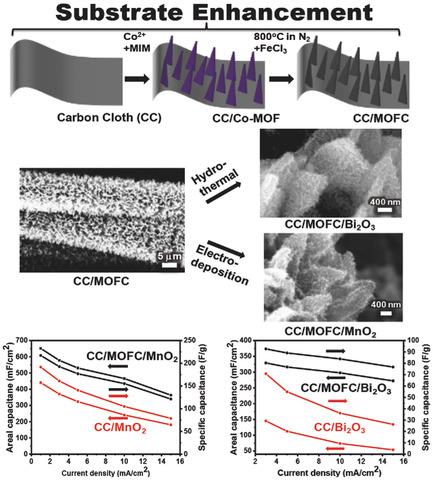Our official English website, www.x-mol.net, welcomes your feedback! (Note: you will need to create a separate account there.)
2D Metal–Organic Frameworks Derived Nanocarbon Arrays for Substrate Enhancement in Flexible Supercapacitors
Small ( IF 13.3 ) Pub Date : 2017-10-27 , DOI: 10.1002/smll.201702641 Ximeng Liu 1 , Cao Guan 1 , Yating Hu 1 , Lei Zhang 1 , Abdelnaby M. Elshahawy 1 , John Wang 1
Small ( IF 13.3 ) Pub Date : 2017-10-27 , DOI: 10.1002/smll.201702641 Ximeng Liu 1 , Cao Guan 1 , Yating Hu 1 , Lei Zhang 1 , Abdelnaby M. Elshahawy 1 , John Wang 1
Affiliation

|
Direct assembling of active materials on carbon cloth (CC) is a promising way to achieve flexible electrodes for energy storage. However, the overall surface area and electrical conductivity of such electrodes are usually limited. Herein, 2D metal–organic framework derived nanocarbon nanowall (MOFC) arrays are successfully developed on carbon cloth by a facile solution + carbonization process. Upon growth of the MOFC arrays, the sites for growth of the active materials are greatly increased, and the equivalent series resistance is decreased, which contribute to the enhancement of the bare CC substrate. After decorating ultrathin flakes of MnO2 and Bi2O3 on the flexible CC/MOFC substrate, the hierarchical electrode materials show an abrupt improvement of areal capacitances by around 50% and 100%, respectively, compared to those of the active materials on pristine carbon cloth. A flexible supercapacitor can be further assembled using two hierarchical electrodes, which demonstrates an energy density of 124.8 µWh cm−2 at the power density of 2.55 mW cm−2.
中文翻译:

二维金属有机框架衍生的纳米碳阵列,用于增强柔性超级电容器中的基板
将活性材料直接组装在碳布(CC)上是一种实现用于储能的柔性电极的有前途的方法。但是,这种电极的总表面积和电导率通常受到限制。在这里,二维金属-有机骨架衍生的纳米碳纳米壁(MOFC)阵列是通过简便的溶液+碳化过程成功开发在碳布上的。随着MOFC阵列的生长,活性材料的生长部位大大增加,并且等效串联电阻减小,这有助于裸CC基底的增强。装饰后的MnO 2和Bi 2 O 3超薄薄片与原始碳布上的活性材料相比,在柔性CC / MOFC基板上的分层电极材料分别显示出面积电容的突然改善,分别提高了约50%和100%。可以使用两个分层电极进一步组装柔性超级电容器,这两个超级电极在2.55 mW cm -2的功率密度下显示出124.8 µWh cm -2的能量密度。
更新日期:2017-10-27
中文翻译:

二维金属有机框架衍生的纳米碳阵列,用于增强柔性超级电容器中的基板
将活性材料直接组装在碳布(CC)上是一种实现用于储能的柔性电极的有前途的方法。但是,这种电极的总表面积和电导率通常受到限制。在这里,二维金属-有机骨架衍生的纳米碳纳米壁(MOFC)阵列是通过简便的溶液+碳化过程成功开发在碳布上的。随着MOFC阵列的生长,活性材料的生长部位大大增加,并且等效串联电阻减小,这有助于裸CC基底的增强。装饰后的MnO 2和Bi 2 O 3超薄薄片与原始碳布上的活性材料相比,在柔性CC / MOFC基板上的分层电极材料分别显示出面积电容的突然改善,分别提高了约50%和100%。可以使用两个分层电极进一步组装柔性超级电容器,这两个超级电极在2.55 mW cm -2的功率密度下显示出124.8 µWh cm -2的能量密度。



























 京公网安备 11010802027423号
京公网安备 11010802027423号